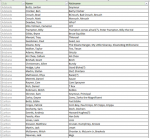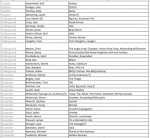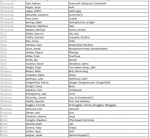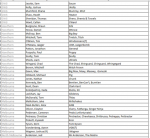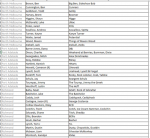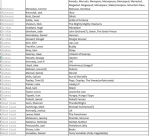My thoughts on SC scoring, warning essay incoming.
From playing SC over the years, I think that scaling has become a bit of a bogeyman, with people overrating the influence of scaling and that the actual effect of reduced scores for kicks, etc during blowouts is not as big as people think it is. Instead the main issues causing confusion over SC scoring are:
1. The way live SC scores are updated and normalised
and
2. Champion Data do not explicitly tell us what stats they record, let alone what points are scored from those stats
Number 2 has the biggest influence, but I’ll start with 1.
SC Live Scores
Since the combined SC of every game has to add up to 3300 but CD don’t know how many kicks, goals, etc are going to be in each game, they have to make assumptions when creating the live scores. The main assumption being that the rate of the scoring for the rest of the game is going to stay the same.
So let’s take an extreme example. Imagine that at half time a game is tied at 0 with both teams playing horribly and running at 10% disposal efficiency. The total SC scores will be about 1650 as CD will assume that the 2nd half will be played in the same manner. And let’s say that Player A is on 50 points at half time, but falls off the massage table and doesn’t play in the second half. If both teams come out and play brilliantly in the 2nd half, kicking 25 goals straight, CD’s assumption of the scoring rate will have been wrong, and they would have overestimated the worth of the points scored in the 1st half. Therefore Player A’s score will go down, probably rather drastically in this example.
Most people don’t take this normalisation into account, and think of it more like DT, where 50 points = 50 points. This is most apparent in the first few minutes of the game where scores can fluctuate wildly due to the small sample size of actions.
The other issue with SC live scores are that they are not updated in real time, but instead updated in batches every 30 seconds or so. This can make it difficult to determine which points were scored for which action. “OMG!! HE ONLY GOT 1 POINT FOR THAT MARK AND KICK!!!!!” Maybe the mark was at the 28th second of the last batch and the kick will be included in the next batch. Or maybe he had a clanger 20 seconds earlier which was included as well.
Champion Data Scoring
But the main issue is that CD does not tell us what stats they collect nor how they score them. We know that they record 50+ different stats and they have mentioned some of them in the past. But since their goal is to try to determine the actual influence of a player within a game (rather than raw possession counts, marks, etc.) we can start to make some assumptions.
Due to the increase of player skills over the past decades, in the modern AFL the #1 goal is possession. Gaining possession, keeping possession, preventing the opposition from easily maintaining possession, pressuring your opponent into losing possession. Some teams focus more on some aspects than others, but these are the cornerstones of the current AFL. Therefore we can break down the game into 3 states.

Performing actions that move up states score you extra points, while actions that move down generally either score minimal or negative points. Therefore how a player scores points is due to the following three things:
1. How they use the ball (possessions, kick/handball ratios, disposal efficiency %)
2. How they get the ball (contested vs. uncontested possessions/marks)
3. Defense (tackles, spoils, smothers, causing turnovers)
Most people focus mainly on #1, comparing players by posting raw possession counts, DE%, etc. But the other two, especially #2 above are not given enough consideration. If you are watching live and are interested in SC scoring, I’ve found that the best question to ask yourself is this:
“Who won the ball?”
I’m not talking about which player got the clearance (meaningless), I’m talking about which player was responsible for their team winning the ball when it was in dispute. This could be a Hitout-to-advantage from a ruckmen, a ground ball get from a midfielder or even a tap along the ground to an open teammate. That last one is actually rather important, because it is something that doesn’t show up on any of the stat sheets we have access to, but CD definitely record it and include it in SC scores. Which leads us to...
Not All Stats are Created Equal (plus Hidden Stats)
You often hear complaints that CD somehow have favourites, that some players have the golden SC ticket, that players are gaining points for “doing nothing”. And yes I’m aware that there is some human judgement involved in determining whether a kick was ineffective or a clanger, but for the most part there are reasons why some players are scoring more than other players. It’s because the actions they do are more valuable actions than other players, and because they do things that don’t show up on the traditional stat sheets. This includes most of the defensive actions which outside of tackles, aren’t really widely recorded.
Let’s take a somewhat hidden stat: Spoils. These don’t show up on the live stats but are included after the game. I think it was early in the Collingwood/Essendon game when Darcy Moore was on 0DT:10SC a few minutes into the game with a completely empty stat line next to him. But he had spoiled 3 marking contests to that point, earning him 10SC. 3+ points per spoil seems a bit excessive don’t you think? Well let me ask you a question: How many of you know that CD actually record 3 different spoil stats? They seem to be:
Spoil-to-advantage (teammate picks up the loose ball): ~3 points
Spoil-neutral (loose ball is in dispute or out of bounds): ~2 points
Spoil-to-disadvantage (opponent picks up the loose ball): ~1 point
So not all spoils are created equal, you not only need to look at what a player did, you also have to look at the consequences of those actions as well.
This is the core problem we have. The stats we have access to (especially in-game) are only a summary of what CD are recording. Let’s look at a popular one:
Effective kicks
According to the stats we have, kicks are either effective, ineffective or a clanger. But CD have an entire range of stats recording effective kicks. I’m not sure exactly what they are, but the following would be a rough guess of the types of effective kicks they record, which are all scored differently:
- Long kick to an open player
- Long forward kick to a 50:50 contest
- Medium kick to an open player
- Short kick to an open player
And this isn’t even taking into account the directionality of the kicks, nor where they are happening on the ground. A short kick from the back pocket to an open player in the goalsquare probably scores you maybe 1 point. A long kick from the centre square to an open player 30m out from goal probably earns you 6+ points (not including goal assists or anything else). So trying to compare one effective kick with another effective kick without actually watching the game is impossible.
Even effective kicks that gain the same metres are scored differently. A 50m kick down the line to an open player is scored more than 50m kick down the line to a contest. They both show up as an effective kick that gained 50m but one is scored higher than the other. This is a big reason why Jake Lloyd scores so well. He has a high disposal efficiency plus the majority of his kicks are long kicks to open players, not to contests.
Contested Possessions
CPs are another stat that summarise a whole collection of different actions. According to the AFL, CPs are looseball-gets, hardball-gets, contested marks, gathers from a hit-out and frees for. And those are just the AFL stats, I’m sure CD have a whole bunch of different types of these actions as well. All of these are scored at different rates so trying to compare 2 different players based on CP counts is always going to be difficult, unless you are actually watching the game and making note of what type of CPs they are, where they are occurring on the field, etc.
Let's compare 2 examples:
- Grundy wins a hitout-to-advantage to Pendlebury who then handballs
- Gawn wins a hitout but the ball falls into dispute where it is picked up by Oliver who then handballs
In both cases Pendlebury and Oliver gain a CP, but Oliver earns more for his because he "won" the ball, while Grundy "won" the ball in the first example.
Lachie Neale
Let’s summarise by considering Lachie Neale’s 3rd quarter last week. Earlier in the thread there was talk of scaling playing a part in his big 3rd quarter score. This for the most part is BS. The main reason he was scored highly because he was doing things like this:

I was watching this game live, and am a Neale owner, and when this happened I said to myself “KA-CHING!”. Why? Because that one play is emblematic of how CD score the game. That one play earned Neale at least 12 points, probably even more than that. The ball was in dispute, he won the ball in a hard contest, bounced, and then kicked a 40m kick to a wide open player in an attacking position who was able to kick an uncontested goal. Yet people not watching the actual game will see that as a CP and an effective kick, maybe a goal assist if that stat is available, without realising how valuable that play actually was.
So keep asking yourself
"Who won the ball?"
From playing SC over the years, I think that scaling has become a bit of a bogeyman, with people overrating the influence of scaling and that the actual effect of reduced scores for kicks, etc during blowouts is not as big as people think it is. Instead the main issues causing confusion over SC scoring are:
1. The way live SC scores are updated and normalised
and
2. Champion Data do not explicitly tell us what stats they record, let alone what points are scored from those stats
Number 2 has the biggest influence, but I’ll start with 1.
SC Live Scores
Since the combined SC of every game has to add up to 3300 but CD don’t know how many kicks, goals, etc are going to be in each game, they have to make assumptions when creating the live scores. The main assumption being that the rate of the scoring for the rest of the game is going to stay the same.
So let’s take an extreme example. Imagine that at half time a game is tied at 0 with both teams playing horribly and running at 10% disposal efficiency. The total SC scores will be about 1650 as CD will assume that the 2nd half will be played in the same manner. And let’s say that Player A is on 50 points at half time, but falls off the massage table and doesn’t play in the second half. If both teams come out and play brilliantly in the 2nd half, kicking 25 goals straight, CD’s assumption of the scoring rate will have been wrong, and they would have overestimated the worth of the points scored in the 1st half. Therefore Player A’s score will go down, probably rather drastically in this example.
Most people don’t take this normalisation into account, and think of it more like DT, where 50 points = 50 points. This is most apparent in the first few minutes of the game where scores can fluctuate wildly due to the small sample size of actions.
The other issue with SC live scores are that they are not updated in real time, but instead updated in batches every 30 seconds or so. This can make it difficult to determine which points were scored for which action. “OMG!! HE ONLY GOT 1 POINT FOR THAT MARK AND KICK!!!!!” Maybe the mark was at the 28th second of the last batch and the kick will be included in the next batch. Or maybe he had a clanger 20 seconds earlier which was included as well.
Champion Data Scoring
But the main issue is that CD does not tell us what stats they collect nor how they score them. We know that they record 50+ different stats and they have mentioned some of them in the past. But since their goal is to try to determine the actual influence of a player within a game (rather than raw possession counts, marks, etc.) we can start to make some assumptions.
Due to the increase of player skills over the past decades, in the modern AFL the #1 goal is possession. Gaining possession, keeping possession, preventing the opposition from easily maintaining possession, pressuring your opponent into losing possession. Some teams focus more on some aspects than others, but these are the cornerstones of the current AFL. Therefore we can break down the game into 3 states.

Performing actions that move up states score you extra points, while actions that move down generally either score minimal or negative points. Therefore how a player scores points is due to the following three things:
1. How they use the ball (possessions, kick/handball ratios, disposal efficiency %)
2. How they get the ball (contested vs. uncontested possessions/marks)
3. Defense (tackles, spoils, smothers, causing turnovers)
Most people focus mainly on #1, comparing players by posting raw possession counts, DE%, etc. But the other two, especially #2 above are not given enough consideration. If you are watching live and are interested in SC scoring, I’ve found that the best question to ask yourself is this:
“Who won the ball?”
I’m not talking about which player got the clearance (meaningless), I’m talking about which player was responsible for their team winning the ball when it was in dispute. This could be a Hitout-to-advantage from a ruckmen, a ground ball get from a midfielder or even a tap along the ground to an open teammate. That last one is actually rather important, because it is something that doesn’t show up on any of the stat sheets we have access to, but CD definitely record it and include it in SC scores. Which leads us to...
Not All Stats are Created Equal (plus Hidden Stats)
You often hear complaints that CD somehow have favourites, that some players have the golden SC ticket, that players are gaining points for “doing nothing”. And yes I’m aware that there is some human judgement involved in determining whether a kick was ineffective or a clanger, but for the most part there are reasons why some players are scoring more than other players. It’s because the actions they do are more valuable actions than other players, and because they do things that don’t show up on the traditional stat sheets. This includes most of the defensive actions which outside of tackles, aren’t really widely recorded.
Let’s take a somewhat hidden stat: Spoils. These don’t show up on the live stats but are included after the game. I think it was early in the Collingwood/Essendon game when Darcy Moore was on 0DT:10SC a few minutes into the game with a completely empty stat line next to him. But he had spoiled 3 marking contests to that point, earning him 10SC. 3+ points per spoil seems a bit excessive don’t you think? Well let me ask you a question: How many of you know that CD actually record 3 different spoil stats? They seem to be:
Spoil-to-advantage (teammate picks up the loose ball): ~3 points
Spoil-neutral (loose ball is in dispute or out of bounds): ~2 points
Spoil-to-disadvantage (opponent picks up the loose ball): ~1 point
So not all spoils are created equal, you not only need to look at what a player did, you also have to look at the consequences of those actions as well.
This is the core problem we have. The stats we have access to (especially in-game) are only a summary of what CD are recording. Let’s look at a popular one:
Effective kicks
According to the stats we have, kicks are either effective, ineffective or a clanger. But CD have an entire range of stats recording effective kicks. I’m not sure exactly what they are, but the following would be a rough guess of the types of effective kicks they record, which are all scored differently:
- Long kick to an open player
- Long forward kick to a 50:50 contest
- Medium kick to an open player
- Short kick to an open player
And this isn’t even taking into account the directionality of the kicks, nor where they are happening on the ground. A short kick from the back pocket to an open player in the goalsquare probably scores you maybe 1 point. A long kick from the centre square to an open player 30m out from goal probably earns you 6+ points (not including goal assists or anything else). So trying to compare one effective kick with another effective kick without actually watching the game is impossible.
Even effective kicks that gain the same metres are scored differently. A 50m kick down the line to an open player is scored more than 50m kick down the line to a contest. They both show up as an effective kick that gained 50m but one is scored higher than the other. This is a big reason why Jake Lloyd scores so well. He has a high disposal efficiency plus the majority of his kicks are long kicks to open players, not to contests.
Contested Possessions
CPs are another stat that summarise a whole collection of different actions. According to the AFL, CPs are looseball-gets, hardball-gets, contested marks, gathers from a hit-out and frees for. And those are just the AFL stats, I’m sure CD have a whole bunch of different types of these actions as well. All of these are scored at different rates so trying to compare 2 different players based on CP counts is always going to be difficult, unless you are actually watching the game and making note of what type of CPs they are, where they are occurring on the field, etc.
Let's compare 2 examples:
- Grundy wins a hitout-to-advantage to Pendlebury who then handballs
- Gawn wins a hitout but the ball falls into dispute where it is picked up by Oliver who then handballs
In both cases Pendlebury and Oliver gain a CP, but Oliver earns more for his because he "won" the ball, while Grundy "won" the ball in the first example.
Lachie Neale
Let’s summarise by considering Lachie Neale’s 3rd quarter last week. Earlier in the thread there was talk of scaling playing a part in his big 3rd quarter score. This for the most part is BS. The main reason he was scored highly because he was doing things like this:

I was watching this game live, and am a Neale owner, and when this happened I said to myself “KA-CHING!”. Why? Because that one play is emblematic of how CD score the game. That one play earned Neale at least 12 points, probably even more than that. The ball was in dispute, he won the ball in a hard contest, bounced, and then kicked a 40m kick to a wide open player in an attacking position who was able to kick an uncontested goal. Yet people not watching the actual game will see that as a CP and an effective kick, maybe a goal assist if that stat is available, without realising how valuable that play actually was.
So keep asking yourself
"Who won the ball?"

